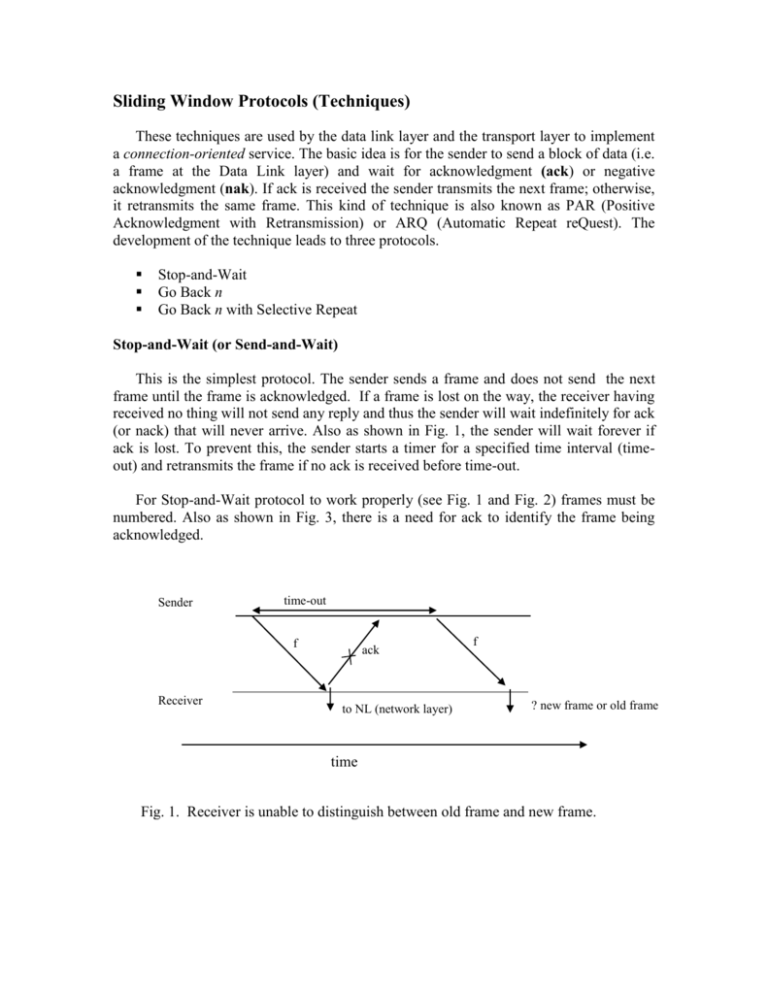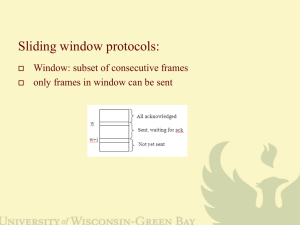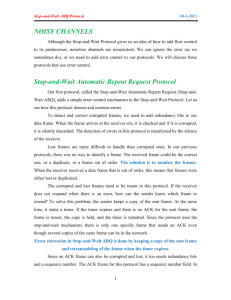SlidingWindow
advertisement

Sliding Window Protocols (Techniques) These techniques are used by the data link layer and the transport layer to implement a connection-oriented service. The basic idea is for the sender to send a block of data (i.e. a frame at the Data Link layer) and wait for acknowledgment (ack) or negative acknowledgment (nak). If ack is received the sender transmits the next frame; otherwise, it retransmits the same frame. This kind of technique is also known as PAR (Positive Acknowledgment with Retransmission) or ARQ (Automatic Repeat reQuest). The development of the technique leads to three protocols. Stop-and-Wait Go Back n Go Back n with Selective Repeat Stop-and-Wait (or Send-and-Wait) This is the simplest protocol. The sender sends a frame and does not send the next frame until the frame is acknowledged. If a frame is lost on the way, the receiver having received no thing will not send any reply and thus the sender will wait indefinitely for ack (or nack) that will never arrive. Also as shown in Fig. 1, the sender will wait forever if ack is lost. To prevent this, the sender starts a timer for a specified time interval (timeout) and retransmits the frame if no ack is received before time-out. For Stop-and-Wait protocol to work properly (see Fig. 1 and Fig. 2) frames must be numbered. Also as shown in Fig. 3, there is a need for ack to identify the frame being acknowledged. Sender time-out f Receiver ack to NL (network layer) f ? new frame or old frame time Fig. 1. Receiver is unable to distinguish between old frame and new frame. time-out Sender f1 f1 ack f2 ack Receiver to NL not passed to NL time Fig. 2. Receiver is able to distinguish between old frame and new frame. ? ack for f2 or f1 time-out Sender f2 f1 ? send f2 or f3 f1 ack ack Receiver Fig. 3. Sender is unsure about which frame to send next. frame 0 - not passed to NL time-out Sender (1,1) (0,0) (0,0) (0,1) (1,1) (0,1) Receiver (x,y) : x is seqno of outgoing frame; y is ack no (i.e. seqno of awaited frame) Fig. 4. Use of SeqNo and AckNo and Piggy-backing of Acknowledgments. to NL The incorporation of time-out, seqno and ackno solves several problems in Stopand_Wait protocol but one major problem remains. The problem is that the communication channel is wasted during the time the sender is waiting for acknowledgment. With Stop-and-Wait the channel is not used efficiently (i.e. a large percentage of the time the channel is idle). Let us zoom on the frame transmission process as shown in Fig. 5. FTT PD PD ACK (Short frame) Frame waiting and Processing Time (Ignore) Fig. 5. Channel Efficiency (Utilization) for Stop-and-Wait. In the above figure, FTT = Frame Transmission Time = Frame Size (bits) / Channel Bit Rate (bits/sec). PD = Propagation Delay = Distance / Propagation Speed. The Propagation Delay is the time it takes a given bit (signal) to travel (propagate) from one end (sender's end) of the link to the other end (receiver's end). This is independent of the bit rate (Bit Rate is controlled by the physical interface – i.e. Ethernet vs. Fast Ethernet). The Propagation delay is dependent on the distance traveled and the medium propagation speed as given by the formula above. Typical propagation speeds are 300,000 km/sec (speed of light) for fiber optic cables and wireless transmission and 2/3 speed of light for copper media. From the figure above we can see that Channel efficiency (fraction of the time the channel is in use) = FTT / (FTT+2PD), where 2 PD ≡ twice the Propagation Delay ≡ Round Trip Delay. The channel efficiency drops if the round trip delay is significant. One such example is for Satellite channel. A Geostationary Satellite is at height of about 36,000 km. Thus the one-way distance from a sending earth station to a receiving earth station = 72,000 km. Thus the round trip propagation delay = 144,000 km / (300,000 km/sec) ≈ 0.5 sec. Go Back n Protocol Recall that a major problem with Stop-and-Wait is the inefficient use of the communication channel. In particular, the channel efficiency drops if the round trip delay is significant (e.g. for Satellite channels). A proper solution for this problem is to have the sender continue sending additional frames while awaiting acknowledgment. This leads to Go Back n protocol. In a Go Back n protocol the sender sends a maximum of n frames (n being the window size) but does not send a new frame until the acknowledgment for the earliest frame is received. If such acknowledgment is received then the window slides forward (hence the name Sliding Window protocol). If such acknowledgment is not received then the sender must go back and retransmit earlier frames. Also in this protocol the receiver rejects frames that arrive out of order. Fig. 6 below shows Go Back 4. In Go Back n, the number n represents the maximum number of outstanding frames (i.e. frames awaiting acknowledgement). Ideally this number should be large enough such that the sender never needs to go back as shown in Fig. 7. Sender is going back Sender f0 f1 f2 f0 f3 f1 ack Receiver Fig. 6. Go Back 4 Protocol. Window is sliding forward Sender f0 f1 f2 f3 f4 f5 f6 f7 ack Receiver Fig. 7. Ideal Scenario for Go Back n (n =6 so that sender does not go back). Go Back n Protocol with Selective Repeat In a simple Go Back n protocol, the receiver rejects frames that arrive out of order. This implies that the sender may need to retransmit a total of roundtrip delay worth of frames for every frame that is received in error. To rectify this problem, in Go Back n with Selective Repeat, the receiver will buffer the frames that arrive out of order. Suppose the sender is told to Repeat a particular frame (say with seqno=y) while sending frame x. Then he would retransmit frame y then follow it by frames numbered: x+1, x=2 ... etc. Sender is asked to repeat f0 Sender f0 f1 f2 f3 f4 SR0 Receiver Fig. 8. Go Back 6 with Selective Repeat. f5 f0 f6






